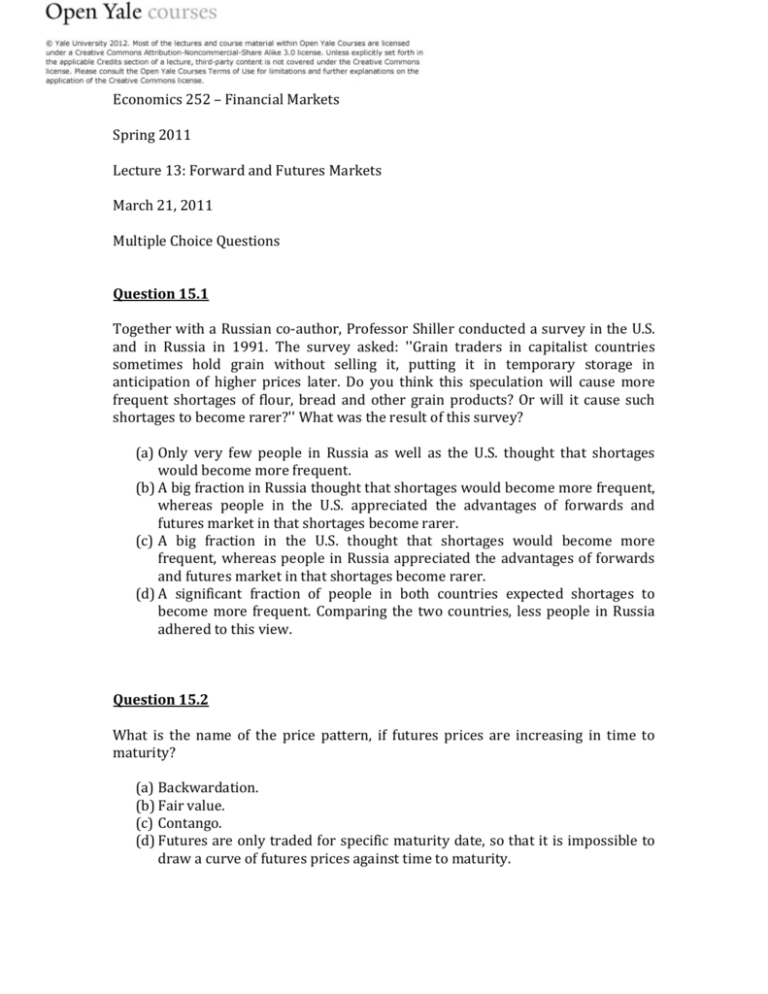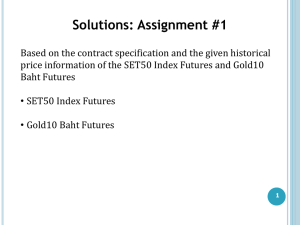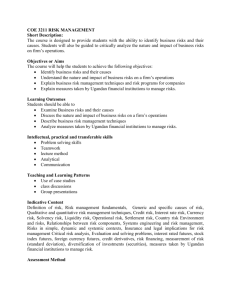Multiple-Choice Quiz (with answer key)
advertisement

Economics 252 – Financial Markets Spring 2011 Lecture 13: Forward and Futures Markets March 21, 2011 Multiple Choice Questions Question 15.1 Together with a Russian co-author, Professor Shiller conducted a survey in the U.S. and in Russia in 1991. The survey asked: ''Grain traders in capitalist countries sometimes hold grain without selling it, putting it in temporary storage in anticipation of higher prices later. Do you think this speculation will cause more frequent shortages of flour, bread and other grain products? Or will it cause such shortages to become rarer?'' What was the result of this survey? (a) Only very few people in Russia as well as the U.S. thought that shortages would become more frequent. (b) A big fraction in Russia thought that shortages would become more frequent, whereas people in the U.S. appreciated the advantages of forwards and futures market in that shortages become rarer. (c) A big fraction in the U.S. thought that shortages would become more frequent, whereas people in Russia appreciated the advantages of forwards and futures market in that shortages become rarer. (d) A significant fraction of people in both countries expected shortages to become more frequent. Comparing the two countries, less people in Russia adhered to this view. Question 15.2 What is the name of the price pattern, if futures prices are increasing in time to maturity? (a) Backwardation. (b) Fair value. (c) Contango. (d) Futures are only traded for specific maturity date, so that it is impossible to draw a curve of futures prices against time to maturity. Question 15.3 Consider the fair value equation for a commodities future, relating the futures price to the risk-free interest rate, a positive storage cost, and the spot price. This fair value equation implies that futures prices should be increasing in the time to maturity. Does this necessarily imply that any backwardated price pattern represents an exploitable profit opportunity? (a) Actually, the described fair value equation implies a backwardated price pattern, not a contango price pattern. (b) No, the underlying commodity might involve a convenience yield, which may cause a backwardated price pattern. (c) Yes, backwardated prices always represent an exploitable profit opportunity. (d) The stated fair value equation does not apply to commodity futures. Question 15.4 Which of the following statements is true about oil markets from 1870 until today? (More than one answer may apply.) (a) From the 1940s until the 1960s, the Texas Railroad Commission worked to stabilize oil prices. (b) The first oil crisis in 1973-1974 was created by a blockade against oil in oilproducing countries outside the U.S. (c) The second oil crisis in 1979-1980 was associated with the Iranian revolution that led to the fall of the Shah of Iran. (d) The spikes in oil prices mentioned in class have, at the time of their occurrence, produced booms in the U.S. economy. Question 15.5 Consider futures contracts with the S&P 500 index as the underlying. How are these contracts settled at the maturity date? (a) The short position in the futures contract has to make sure to deliver all 500 stocks that are represented in the S&P 500 index in the appropriate numbers to exactly replicate the index composition. (b) The short position in the futures contract has to deliver shares in an index fund that tracks the S&P 500. (c) The long position in the futures contract has to deliver shares in an index fund that tracks the S&P 500. (d) S&P 500 futures are cash settled, that is only money changes hands according to the difference between the price specified in the futures contract and the current value of the S&P 500. Correct Answers 15.1: (d) 15.2: (c) 15.3: (b) 15.4: (a), (b) and (c) 15.5: (d)





